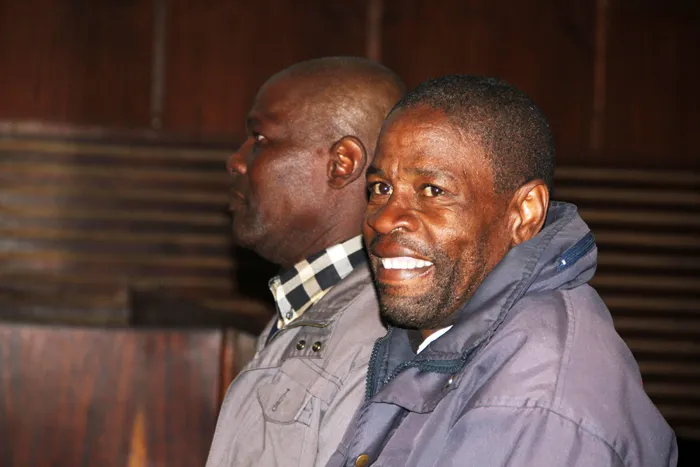Soldier found guilty of Kimberley Boys’ High pupil’s murder

Mbubanzi Desmond Zwakala and his co-accused, David Khangumbe, in the Northern Cape High Court.
Image: Sandi Kwon Hoo / DFA
SOUTH African National Defence Force (SANDF) soldier Mbubanzi Desmond Zwakala was found guilty, while his co-accused, David Khangumbe, was found not guilty of the murder of Kimberley Boys’ High School pupil Amogelang Assegaai.
The Grade 12 pupil was fatally shot outside his home in Impala Road, Verwoerdpark, in October 2022.
Acting Judge Dries van Tonder delivered judgment in the Northern Cape High Court on July 3, with the courtroom filled to capacity by family members, supporters, and friends.
The shooting followed an earlier altercation involving Zwakala’s son and Assegaai.
Zwakala’s son, Kamva Zwakala, was injured during a valedictory party following an altercation when Assegaai reportedly asked him to leave, as the house was overcrowded.
Zwakala later confronted Assegaai on October 23, 2022, to retrieve his son’s cellphone, which had been lost during the altercation. The confrontation turned hostile when Zwakala realised the SIM and memory cards were missing from the phone.
Zwakala fired a shot with a semi-automatic pistol and, according to the post-mortem report, the bullet entered Assegaai’s left shoulder and travelled down his lung and rib.
During closing arguments this week, State advocate Sue-Anne Weyers-Gericke pointed out that the altercation at Assegaai’s home was between peers.
"The deceased did not show a pattern of aggression. This is while the accused is much bigger, stronger and older than the deceased,” she said.
Weyers-Gericke pointed out that Zwakala arrived at the deceased’s home with a loaded firearm, which he concealed and could not explain why.
She contended that Zwakala was not provoked and had no reason to fire a shot.
“He had no reason to shoot and could not have been acting in self-defence. The accused became aggressive when he discovered that his son’s SIM and memory card were missing from his cellphone. The cellphone was not visibly damaged.
“A witness. Nkosinathi Mhlaba, who attended the valedictory party and accompanied the accused to the deceased’s house, heard a loud bang and saw the deceased grab his shoulder before he fell down. He was familiar with the accused and had no reason to falsely implicate them."
She added that Khangumbe drove Zwakala to the house at about 60 kilometres per hour.
"He simultaneously switched the ignition on when the shot went off. He did not act surprised and sped off at 100km/h with the headlights switched off. The accused must have heard the deceased screaming for help while they offered him no assistance. Zwakala uttered the words ‘good’ when he learnt that the deceased had passed away.”
She further noted that there was no scorching or gunpowder residue on Assegaai’s clothing.
"His T-shirt appeared to have been pulled away and his skin was exposed before the shot was fired. Paramedics had difficulty treating him as they could not see where he was injured. The muzzle of the firearm was about 20 to 30 centimetres from its target. The entry wound was smooth, which refutes the assertion that the bullet could have ricocheted. Forensic pathologist Dr Lemaine Fouche testified that the bullet was fired in a slightly downward and backwards position.”
Weyers-Gericke also revealed that both accused had their phones switched off simultaneously and that there had been cellphone communication between them before and after the incident.
The State withdrew the charge of obstructing the course of justice against Khangumbe.
Defence questions a missing exhibit
Advocate Sakkie Nel, representing Zwakala, questioned why the deceased’s T-shirt was not tested for gunpowder residue.
“The T-shirt is gone and no one can explain what happened to it.”
Nel argued it was plausible that the bullet ricocheted after a warning shot was fired.
“It could have ricocheted off the wall of the carport and hit the deceased’s shoulder. There was a bullet in the chamber as the accused used his firearm for self-defence. It was concealed as he did not want his son and Mhlaba to see it. It would make no sense to bring eyewitnesses to the scene if he intended to shoot someone. The State has not proven beyond a reasonable doubt that the accused shot the deceased at point-blank range.”
Nel explained that the lack of cellphone activity could be attributed to his client making use of an old cellphone that “did not even have WhatsApp”.
“The accused could have run out of data or had no access to the internet. Even if my client contradicted himself when he testified, it does not mean that he committed murder.”
Nel argued there was no evidence of common purpose.
“Khangumbe was not aware of what was going to happen. He only transported Zwakala to the home of the deceased. The accused should be acquitted of murder and a charge of culpable homicide should be considered.”
Khangumbe’s legal representative, advocate Khulani Biyela, stated that his client denied any involvement in any plan to commit murder.
“Zwakala requested Khangumbe to drive him. There was no prior agreement to commit an offence, and therefore, he cannot be considered an accessory. He happened to be a spectator and cannot be held liable for the crime. The deceased was still alive when my client left the scene.”